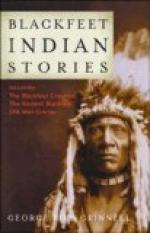When the Americans first met them on the prairie, the Blackfeet were known as great warriors. But up to the time when they got from the Hudson Bay traders better weapons than they had before known, whether these were metal knives, steel arrow points, or guns, it is probable that they did not do much fighting. There seems to have been no reason why they should have fought, unless they quarrelled about small matters with other tribes. It became quite different when the Indians procured better arms and, above all, when they got horses—a means of swiftly getting about over the country, something that all people wanted to have and which all were so eager to obtain that they would go into danger for them. In the old days of stone arrow heads, when they had to travel on foot and to carry heavy loads on their backs, the whole thought and effort of the tribe must have been devoted to the work of procuring a supply of food.
The tribal and family life of the people was simple and friendly. The man and his wives loved each other and loved their children. Relationship counted for much in an Indian camp, and cousins of remote degree were called brother and sister. Children were not punished; they were trained by persuasion and advice. They were told by older people how they ought to act in order to make their lives happy and successful and to be well thought of by their fellows. Young people had much respect for their elders, listened to what they said, and strove more or less successfully to follow their teachings.
The Blackfeet were very religious. They feared many natural powers and influences whose workings they did not understand, and they were constantly praying to the Sun—regarded as the ruler of the universe—as well as to those other powers which they believe live in the stars, the earth, the mountains, the animals, and the trees. The Blackfoot was constantly afraid that some evil thing might happen to him, and he therefore prayed to all the powers for help—for good fortune in his undertakings, for health, plenty, and long life for himself and all his family.
Among these tribes there are a number of secret societies known as the All Comrades or All Friends—groups of men of different ages, which have been alluded to in the stories. Originally there were about twelve of these societies, but a number have been abandoned of recent years.
The tribe was divided into a number of clans, all the members of which were believed to be related, and in old times no member of a clan was permitted to marry another member of the clan. Relations might not marry.
In olden times, when large numbers of people were together, the lodges of the camp were pitched in a great circle, the opening toward the southeast. In this circle each clan camped in its own particular place with relation to the other clans. Within the circle was often a smaller circle of lodges, each occupied by one or more of the societies of the All Comrades. Sometimes it happened that great numbers of the Blackfeet came together, perhaps even all of the three tribes, Blackfeet, Bloods, and Piegans. When this was the case, each tribe camped by itself with its own circle, no matter how near it might be to one or other of the tribal circles.




